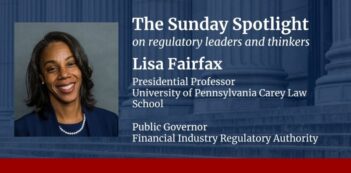
Cost-benefit analysis assumes an increasingly prominent role in financial rulemaking.
Is the enjoyment of an after-dinner coffee worth being kept awake at night and being tired the next day? When we answer that kind of question and many others like it, we evaluate the pros and cons of our choices. In effect, we do a cost-benefit analysis. Although “cost-benefit analysis” may sound like a complex concept, it is actually a practice we engage in daily.
For much the same reasons that we use cost-benefit analysis, government officials conduct cost-benefit analyses when making regulatory decisions. In fact, all three branches of government, other federal agencies, private organizations, and individuals have increasingly encouraged financial regulators to implement cost-benefit analysis in their rulemaking procedures. In response, both the U.S. Securities and Exchange Commission (SEC) and the Financial Industry Regulatory Authority (FINRA) have addressed incorporating cost-benefit analysis in their rulemaking processes, and other financial regulators are following their lead.
The Administrative Conference of the United States (ACUS), a federal agency that works to improve the rulemaking process by performing research and issuing recommendations to other federal agencies, defines cost-benefit analysis in the regulatory sphere as any government agency’s efforts “to estimate the overall benefits that a proposed or final rule would create, as well as the aggregate costs that it would impose on society.” When using cost-benefit analysis, the regulatory agency then assesses whether the benefits of a new regulation warrant the costs.
Executive orders signed by different presidents require Cabinet departments and particular executive agencies to use cost-benefit analysis as part of certain rulemakings. However, independent regulatory agencies, such as financial regulators like the SEC, and self-regulatory organizations, like FINRA, are not subject to requirements outlined in executive orders. In addition, the SEC is not required to use cost-benefit analysis at all.
As described by ACUS, independent regulatory agencies are federal agencies whose leaders cannot be fired by the president without cause. Further, such agencies are “created by an act of Congress” and have some autonomy from the executive branch.
Self-regulatory organizations are not government agencies, but still have the ability to develop and monitor compliance with industry rules. FINRA describes itself as “an independent, not-for-profit organization authorized by Congress to protect America’s investors by making sure the securities industry operates fairly and honestly” by creating regulations and ensuring compliance with these regulations, among other things.
All branches of the government seem to support the use of cost-benefit analysis in rulemaking by financial regulators. For example, although his executive order does not obligate independent agencies to use cost-benefit analysis, President Barack Obama included language in his 2011 order on regulatory review that encourages independent agencies to “take into account benefits and costs, both quantitative and qualitative.”
In addition, in 2011, a federal appeals court struck down an SEC regulation that would have given shareholders more input regarding the members of boards, finding the SEC had conducted deficient cost-benefit analysis of the new rule.
Last year, the SEC responded to calls for cost-benefit analysis by issuing an internal set of standards to guide its rulewriting staff in conducting cost-benefit analyses of new rules. In these internal standards, the SEC acknowledged that conducting good economic analysis is “essential” when the agency develops regulations, and it outlined how its staff should describe and quantify the costs and benefits of proposed rules, handle any uncertainty in the quantification process, and deal with costs and benefits that cannot be quantified. The SEC also suggested involving economists in its Division of Economic and Risk Analysis (DERA) (formerly the Division of Risk, Strategy, and Financial Innovation) as early in the development of new rules as possible because “[c]lose collaboration with [DERA] will help to integrate economic analysis as key policy choices are made.”
Perhaps partially due to trickle-down pressure from the SEC, FINRA also recently adopted a framework for economic impact analysis. According to the framework, FINRA says it will hold discussions with those most impacted by a new or revised rule, among others, throughout the rulemaking process. This is because investors often know how they will best benefit from a rule, while those regulated can best attest to its costs. In addition, FINRA states that it aims to achieve transparency in its notices for rulemaking and rule filings by explaining why FINRA is seeking to adopt or amend a rule and by describing FINRA’s economic analysis and the information underlying it, including any concerns that could impact its cost-benefit analysis. Finally, FINRA says that it will seek “reliable evidence” for its economic impact assessment. In instances where it is not possible to obtain evidence for a cost or benefit, FINRA says it will fully explain any conjectures made in its assessment and the limits of its data. FINRA further explains that both quantitative and qualitative data will be utilized in rulemaking.
Perhaps to ensure application of cost-benefit analysis, several bills have been introduced in Congress in the past year that would require financial regulators to incorporate cost-benefit analysis into their rulemaking procedures. For example, the SEC Regulatory Accountability Act, which passed in the House of Representatives, aims to “improve the consideration by the [SEC] of the costs and benefits of its regulations and orders.” Among other things, the Act would require that the SEC adopt a regulation only if the SEC has determined, in conjunction with the Chief Economist, that the benefits of the regulation merit the costs. The SEC would also be required to apply cost-benefit analysis to any rules “adopted” by the Municipal Securities Rulemaking Board (MSRB) or FINRA before such rules could be implemented.
The Regulatory Accountability Act of 2013, which was introduced in the House, would require (among many reforms) that independent regulatory agencies, like the SEC, conduct cost-benefit analysis for rules and guidance that have a substantial impact on the economy. Dissenters, however, note that executive orders have exempted independent regulatory agencies from cost-benefit analysis. They argue that the Act “would require [independent regulatory agencies] to comply with mandatory guidelines issued by [the Office of Management and Budget] and [the Office of Information and Regulatory Affairs], thereby bringing them under the President’s control. Such a move would contravene Congress’s intent in making them ‘independent’ in the first place.”
Finally, the Independent Agency Regulatory Analysis Act of 2013, introduced in the Senate, would authorize the president to issue executive orders that would compel independent regulatory agencies to conduct and document in-depth cost-benefit analysis for rules that have a significant impact on the economy.
There is considerable debate about the use of cost-benefit analysis by financial regulators. On the one hand, organizations representing the financial industry have continually advocated for agencies like the SEC and FINRA to use cost-benefit analysis. These organizations emphasize that cost-benefit analysis makes rulemaking more transparent and helps achieve the dual goal of protecting investors and ensuring the best use of a financial firm’s resources.
On the other hand, critics fear that emphasis on cost-benefit analysis will inhibit financial regulation. For example, Lynn Turner, a former accountant for the SEC, has reportedly stated that cost-benefit analysis will “put the regulators in a straitjacket in a manner that is almost certain to ensure that we have a repeat of the financial crisis and further destruction of American wealth.”



